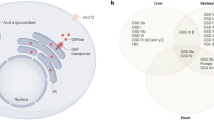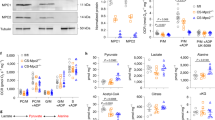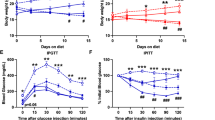Abstract
Glycogen storage disease type III (GSD III) due to debranching enzyme deficiency presenting usually with hepatomegaly and hypoglycemia may be responsible for severe cardiomyopathy which is often fatal. Current treatment of GSD III is based on frequent high-carbohydrate meals that have no effect on the cardiomyopathy. We describe a 2-mo-old infant presenting with a familial form of GSD III complicated with cardiomyopathy. As conventional treatment was unable to improve his sister's cardiomyopathy who was deceased at age 11 mo, we proposed an experimental treatment combining the use of synthetic ketone bodies (d,l-3-OH butyrate) as an alternative energy source, 2:1 ketogenic diet to reduce glucose intake and high-protein diet to enhance gluconeogenesis. Twenty-four months after the onset of this treatment, echocardiography showed an improvement of cardiomyopathy. Growth and liver size remained normal, and no side effects were observed. Blood glucose levels remained within the normal range and insulin levels decreased. These findings show that synthetic ketone bodies as well as low-carbohydrate, high-lipid, and high-protein diet may be a more beneficial therapeutic choice therapeutic choice for GSD III patients with cardiomyopathy. These encouraging data need to be confirmed in more GSD III patients presenting with cardiac or muscular symptoms.
Similar content being viewed by others
Main
Glycogen storage disease (GSD) type III (OMIM 232400) is due to glycogen debranching enzyme (GDE; EC 3.2.1.33) deficiency encoded by the AGL gene. The estimated incidence of the disease is estimated to 1:100,000 live births. The clinical forms of the disease include a predominantly hepatic form (hepatomegaly, hypoglycemia, and hypertriglyceridemia) and a muscular form (myopathy and cardiomyopathy) (1).
Even though we are currently lacking natural history reports, glycogen storage disease type III (GSD III) is associated to a favorable outcome for the hepatic forms as the dietary management is less strict than other GSD such as GSD type I (glucose-6-phosphatase deficiency), whereas the muscular forms are associated with a high morbidity and mortality principally due to cardiomyopathy, source of cardiac failure, and sudden death (1–3).
No consensus on GSD III management is available. However, usual recommendations include high-carbohydrate frequent meals in the day and raw cornstarch or continuous feeding in the night (4), which prevent efficiently fasting hypoglycemia but do not influence usually the course of cardiac and muscular manifestations.
The aim of this study was to assess the potential of d,l-3-hydroxybutyrate (3OHB) along with a ketogenic and high-protein diet during 24 mo to improve the severe cardiomyopathy due to GSD III in an infant of 2 mo.
Patient.
A 2-mo-old male infant of African origin presented with hypertrophic cardiomyopathy. Because of parental consanguinity and a family history of a sister deceased at age 11 mo from severe cardiomyopathy due to GSD III, the diagnosis was rapidly established at birth. His elder sister presented at age 8 mo with hypoglycemia, hepatomegaly associated with an elevation of aspartate transaminase (AST) and alanine transaminase (ALT), and hypertrophic cardiomyopathy associated with high creatine kinase (CK) levels. She was treated with frequent meals and continuous enteral feeding at night to prevent hypoglycemia. Cardiomyopathy deteriorated rapidly during the first month of treatment. Because of several episodes of tachycardia, she was treated with acebutolol. A month later, cardiomyopathy was unchanged but tachycardia resolved. She eventually died at age 11 mo from cardiac arrest.
Enzyme activity measurement displayed absent GDE activity in fresh leukocytes while molecular analysis identified a c.2157 + 1G>T homozygous splice mutation in intron 16–17 of the AGL gene. This sequence variation has not been reported before but is predicted to affect the splice donor site and thus to be pathogenic.
Besides asymptomatic hypertrophic cardiomyopathy, the boy, similar to his sister, displayed hepatomegaly, fasting hypoglycemia, and hypertriglyceridemia that were managed by a conventional dietary approach with frequent meals and continuous night feeding through a nasogastric tube. A 24-h Holter-ECG recording did not show any heart rhythm disorder.
As the sister's condition worsened quickly under high-carbohydrate diet, we hypothesized that the latter may deteriorate the cardiomyopathy in GSD III by enhancing glycogen accumulation as reported in the literature (5,6).
Moreover, we hypothesized that high insulin secretion induced by a high-carbohydrate diet may inhibit lipolysis and thus energy availability for the heart by reducing acetyl-CoA and ketone bodies formation by fatty acid oxidation (FAO). Consequently, we decided to decrease the carbohydrate intake to limit glycogen accumulation and to increase the lipid intake to enhance FAO and ketogenesis. To maintain normal glucose levels in plasma, we proposed to enhance neoglucogenesis by increasing the availability of gluconeogenic substrates such as glycerol (from the ketogenic diet) and aminoacids by a high-protein diet. Finally, we introduced d,l-3-hydroxybutyrate as an alternative energy substrate for the heart.
METHODS
We started the patient on a diet providing 65% of energy from lipids, 15% from protein, and 20% from glucose (for detailed composition of the diet, see Table 1). We used continuous feeding through a nasogastric tube during the 6 first months to avoid hypoglycemia due to the low-glucose intake. From mo 7, we introduced oral feedings, and by mo 12, the child received four meals and a night feeding. 3OHB was started at the dose of 400 mg/kg/d, given every 3 h as previously reported (7). Figure 1 displays the diet modifications during the study in carbohydrate, lipid, and protein intake expressed in % of the total energy intake (TEI) during the 24 mo of the trial, and the progressive increase of the 3OHB dose up to 800 mg/kg/d. The carbohydrate intake was dramatically reduced from 65 to 20% of the TEI (4 g/kg/d), whereas the lipid and protein intake were increased to 65% (6 g/kg/d) and 15% (3 g/kg/d) respectively.
Change in carbohydrate (□), lipid (▪), and protein ( ) intake expressed in % of the total energy intake (left axis), in protein expressed in g/kg (hatched columns, left axis), and in glucose rate in mg/kg/min (black dotted curve, right axis) during the trial. Arrows indicate the doses of 3OHB during the trial.
) intake expressed in % of the total energy intake (left axis), in protein expressed in g/kg (hatched columns, left axis), and in glucose rate in mg/kg/min (black dotted curve, right axis) during the trial. Arrows indicate the doses of 3OHB during the trial.
Clinical and biological assessments took place every 3 mo including growth, liver size (clinically and by ultrasonography), liver transaminases, creatine-kinase, plasma glucose, lactate, 3-OH butyrate, acetoacetate, FFA, and serum insulin levels. Cardiac evaluation was done by ultrasonography, standard ECG, and 24-h Holter-ECG monitoring. A Z-score was calculated for each measurement of the interventricular septum.
Informed consent was obtained from the parents, and the study was approved by our Institutional Review Board (Conseil d'Ethique, Necker-Enfants Malades).
RESULTS
The diet and 3OHB treatment were well tolerated. No further hypoglycemia was observed even though the nocturnal glucose rate fell below 2 mg/kg/min during 24-mo follow-up.
Cardiomyopathy improved. Interventricular wall (IVW) thickness significantly decreased from a Z-score of 7.4 to a Z-score of 3.6 at the end of the study (Fig. 2). However, between mo 6 and mo 14, a transient increase of the IVW thickness was observed. This coincided with a decrease in plasma ketone bodies and was reversed after an increase in 3OHB supplementation from 400 to 800 mg/kg/d. On ECG, amplitude of Q waves and Sokolow index decreased and no heartbeat disorder occurred.
Muscle tone remained normal as well as muscular strength, and the child displayed normal motor development and walked unsupported at age 12 mo. Somatic growth remained normal (at 2 y of age).
Liver size increased within the 6 first months of treatment and then remained stable during the study. Liver enzymes although elevated (2.5-fold for both ALT and AST) remained stable during the study. No change was observed in gamma glutamyl transpeptidase (gGT) and alpha-fetoprotein, and no echographic changes were found in the liver.
Creatine-kinase levels were initially elevated (520 U/L; upper reference range, 180) and increased to a maximum of 720 U/L during the first 3 mo and then decreased during the following 9 mo to the initial levels. Glucose and insulin values in plasma decreased during the trial (glucose median: 4.5 mM before and 3.8 mM after treatment; insulin: 4 mU/L before and 1.8 mU/L after treatment), whereas median lactate levels remained stable (median 1.4 mM) even though no high values were recorded before treatment opposed to what is usually observed in patients affected with GSD III. Ketone bodies (3-OH butyrate and aceto-acetate) and FFA increased in plasma as expected (Fig. 3). Cholesterol was normal, but triglycerides values were initially elevated (cholesterol: 3 mM; upper reference range: 4.5 mM; and triglycerides: 2.9 mM; upper reference range: 1 mM) and remained stable during the study.
DISCUSSION
We report the use of synthetic ketone bodies in conjunction with a ketogenic and high-protein diet in an infant of 2 mo bearing a severe familial hepatomuscular form of GSD III complicated with cardiomyopathy and leading to early death in his sibling. We observed an improvement of the cardiomyopathy in our patient and no further heart-related complications during the 24 mo of the study. Moreover, our patient did not develop any muscular symptoms to date.
Ketogenic diet and ketone bodies supplementation resulted in permanent ketosis in our patient. d,l-3-Hydroxybutyrate has been previously successfully used to treat the cardiomyopathy in multiple acyl-CoA dehydrogenase deficiency, a fatty acid oxidation disorder associated with absence of ketosis (7). Other reports highlighted the importance of ketone bodies for heart metabolism by increasing succinate dehydrogenase activity and thus respiratory chain output (8) or their cardioprotective effects after a coronary ischemic event (9). We hypothesize that diet and d,l-3-hydroxybutyrate thereby facilitating ATP generation from FAO and ketolysis may have contributed to the improvement of the cardiomyopathy.
The transient increase of the IVW thickness that was observed between mo 6 and mo 14 was associated with a decrease in the levels of ketosis that was corrected by the increase of d,l-3-hydroxybutyrate doses (from 400 to 800 mg/kg/d) while the diet remained unchanged. The latter suggests that ketosis may reduce the progression of cardiomyopathy.
The glucose-restricted diet led to decreased levels of insulin and possibly to a decrease in glycogen accumulation in the heart as it was shown in an animal model of GDE inhibition where high insulin and lactate levels led to an increase of 50% of glycogen storage (10).
Plasma glucose levels remained within the normal range despite a dramatic decrease in carbohydrate intake probably due to an enhancement of gluconeogenesis by the high levels of glycerol and protein provided by the diet and to the permanent ketosis. Interestingly, in a recent report, cardiomyopathy also improved in a GSD III patient when he started receiving a protein rich diet (11). This was also the case for muscular symptoms improving under a protein rich diet in previous reports (12,13).
No side effects were noted including cholesterol and triglyceride levels, which remained stable during the study. Liver size and liver enzymes remained stable and no changes were observed by ultrasonography, indicating that the diet may also be beneficial for the liver.
CK decreased but remained elevated even though there does not seem to exist any correlation between pathologic changes in the muscle and CK levels in GSD III (14).
In conclusion, we report on a new treatment concept of GSD III with d,l-3-hydroxybutyrate, ketogenic and high-protein diet which was associated with an improvement of cardiomyopathy, a severe and fatal complication of the disease that occurred in our patient's sibling. However, as this is a single patient study, we cannot affirm that our findings are solely due to our therapeutic interventions and could not be related to the variability of the disease even within the same family. These encouraging data need thus to be confirmed in more GSD III patients with cardiomyopathy or muscular symptoms.
Abbreviations
- 3OHB:
-
d,l-3-hydroxybutyrate
- CK:
-
creatine kinase
- FAO:
-
fatty acid oxidation
- GDE:
-
glycogen debranching enzyme
- GSD:
-
glycogen storage disease
- GSD III:
-
glycogen storage disease type III
- IVW:
-
interventricular wall.
References
Smit GP, Fernandes J, Leonard JV, Matthews EE, Moses SW, Odievre M, Ullrich K 1990 The long-term outcome of patients with glycogen storage diseases. J Inherit Metab Dis 13: 411–418
Coleman RA, Winter HS, Wolf B, Gilchrist JM, Chen YT 1992 Glycogen storage disease type III (glycogen debranching enzyme deficiency): correlation of biochemical defects with myopathy and cardiomyopathy. Ann Intern Med 116: 896–900
Momoi T, Sano H, Yamanaka C, Sasaki H, Mikawa H 1992 Glycogen storage disease type III with muscle involvement: reappraisal of phenotypic variability and prognosis. Am J Med Genet 42: 696–699
Fernandes J, Leonard JV, Moses SW, Odievre M, di Rocco M, Schaub J, Smit GP, Ullrich K, Durand P 1988 Glycogen storage disease: recommendations for treatment. Eur J Pediatr 147: 226–228
Akazawa H, Kuroda T, Kim S, Mito H, Kojo T, Shimada K 1997 Specific heart muscle disease associated with glycogen storage disease type III: clinical similarity to the dilated phase of hypertrophic cardiomyopathy. Eur Heart J 18: 532–533
Fiocchi F, Ricci C, Ligabue G, Reggianini L, Modena MG, Cenacchi G, Torricelli P 2008 Cardiac delayed enhancement distribution in extralysosomial glycogen storage disease. Clin Imaging 32: 474–476
Van Hove JL, Grunewald S, Jaeken J, Demaerel P, Declercq PE, Bourdoux P, Niezen-Koning K, Deanfeld JE, Leonard JV 2003 d,l-3-hydroxybutyrate treatment of multiple acyl-CoA dehydrogenase deficiency (MADD). Lancet 361: 1433–1435
Balietti M, Fattoretti P, Giorgetti B, Casoli T, Di Stefano G, Solazzi M, Platano D, Aicardi G, Bertoni-Freddari C 2009 A ketogenic diet increases succinic dehydrogenase activity in aging cardiomyocytes. Ann N Y Acad Sci 1171: 377–384
Zou Z, Sasaguri S, Rajesh KG, Suzuki R 2002 d,[scap]l-3-Hydroxybutyrate administration prevents myocardial damage after coronary occlusion in rat hearts. Am J Physiol Heart Circ Physiol 283: H1968–H1974
Depre C, Hue L 1997 Inhibition of glycogenolysis by a glucose analogue in the working rat heart. J Mol Cell Cardiol 29: 2253–2259
Dagli AI, Zori RT, McCune H, Ivsic T, Maisenbacher MK, Weinstein DA 2009 Reversal of glycogen storage disease type IIIa-related cardiomyopathy with modification of diet. J Inherit Metab Dis DOI: 10.1007/s10545-009-1088-x
Slonim AE, Weisberg C, Benke P, Evans OB, Burr IM 1982 Reversal of debrancher deficiency myopathy by the use of high-protein nutrition. Ann Neurol 11: 420–422
Slonim AE, Coleman RA, Moses WS 1984 Myopathy and growth failure in debrancher enzyme deficiency: improvement with high-protein nocturnal enteral therapy. J Pediatr 105: 906–911
Dai YJ, Chen L, Guo YP, Ren HT, Zhao YH, Wei M, Qiu ZQ, Song HM 2009 [Clinical and pathological features of glycogen storage disease type III]. Zhonghua Yi Xue Za Zhi 89: 1064–1066
Author information
Authors and Affiliations
Corresponding author
Additional information
The authors report no conflicts of interest.
Rights and permissions
About this article
Cite this article
Valayannopoulos, V., Bajolle, F., Arnoux, JB. et al. Successful Treatment of Severe Cardiomyopathy in Glycogen Storage Disease Type III With D,L-3-Hydroxybutyrate, Ketogenic and High-Protein Diet. Pediatr Res 70, 638–641 (2011). https://doi.org/10.1203/PDR.0b013e318232154f
Received:
Accepted:
Issue Date:
DOI: https://doi.org/10.1203/PDR.0b013e318232154f
This article is cited by
-
French recommendations for the management of glycogen storage disease type III
European Journal of Medical Research (2023)
-
Defining metabolic migraine with a distinct subgroup of patients with suboptimal inflammatory and metabolic markers
Scientific Reports (2023)
-
A new phenotype of aldolase a deficiency in a 14 year-old boy with epilepsy and rhabdomyolysis – case report
Italian Journal of Pediatrics (2022)
-
Mathematical model for the estrogen paradox in breast cancer treatment
Journal of Mathematical Biology (2022)
-
The use of sodium DL-3-Hydroxybutyrate in severe acute neuro-metabolic compromise in patients with inherited ketone body synthetic disorders
Orphanet Journal of Rare Diseases (2020)






